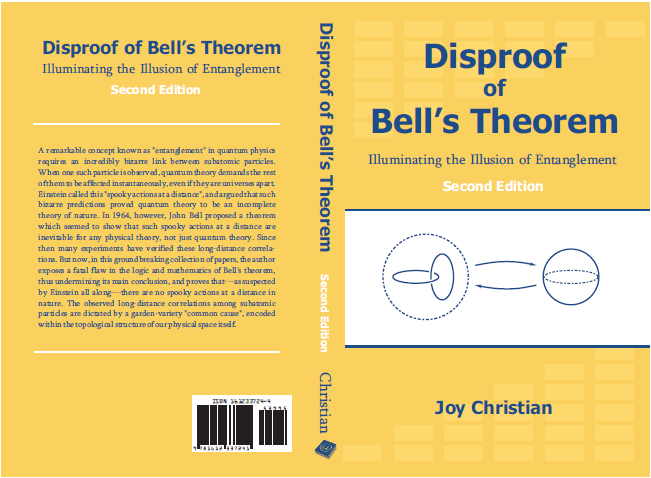The Pearle model as a conspiracy loophole model
Now that we have perfect simulation models, it's maybe time to step
back and ask ourselves what we have achieved. I think there is a little
problem with these simulations.
Note: I refer here to what I call the "clocked" variants
(Michel uses the word "clocked" with the opposite meaning).
For me, clocked means discrete time. For n runs from 1 to N: source
creates emission n, Alice and Bob choose settings n, measurement stations
generate outcomes n. Other words are: pulsed emission, synchronised
experiment, event-ready detectors.
The problem is in the heart of the simulation. In order to generate
outcomes for A and B we obviously need values of the settings
a and b, and we need a realization of the hidden state lambda.
In these Pearle / Thompson like models, lambda is effectively generated by
the rejection method: an initial randomization can generate both states lambda
and non-states - points lambda outside of what Joy defines to be the domain of
A(a, .) and B(b, .). So we just keep picking a lambda from the big set of states
and non-states, till we are lucky enough to get a state.
In both simulation models, the criterion for rejection depends on a and
b. In other words, the domain of the hidden state and hence also its
probability distribution, depends on a and b.
Maybe this only appears to be so? Maybe if you have checked that
some criterion involving a and b is satified, then it is also satisfied for
all possible a' and all possible b', hence it not actually "measurement
setting dependent"? Well, that is what Christian claims, but I have
problems with his use of "for all" and "there exists". And for me
it is clear that Bell's theorem shows that this selection *must* be
measurement-setting dependent. You can only violate Bell's inequality
by violating one of locality, realism, or no-conspiracy. In this case the
simulation is evidently local realist. So it violates "no-conspiracy",
aka "freedom".
In my opinion, the cause of all this sorrow is the attempt to simulate
Christian's S^3 based mathematics within the confines of local realism
on classical computers. That enterprise is doomed to failure ... by Bell's
theorem. Earlier, Christian always admitted this. He always said: you can't
disprove a true mathematical theorem. You have to *circumvent* one.
I believe that Christian's model cannot be reproduced in flatland. It would
need a kind of Möbius strip in space-time which alters the measurement
outcomes (the measurement outcomes which Alice and Bob
saw and collected in their respective labs) as they bring them back in their
space-ships, from their labs on distant planets on distant galaxies,
back to the main lab on Planet Earth.
back and ask ourselves what we have achieved. I think there is a little
problem with these simulations.
Note: I refer here to what I call the "clocked" variants
(Michel uses the word "clocked" with the opposite meaning).
For me, clocked means discrete time. For n runs from 1 to N: source
creates emission n, Alice and Bob choose settings n, measurement stations
generate outcomes n. Other words are: pulsed emission, synchronised
experiment, event-ready detectors.
The problem is in the heart of the simulation. In order to generate
outcomes for A and B we obviously need values of the settings
a and b, and we need a realization of the hidden state lambda.
In these Pearle / Thompson like models, lambda is effectively generated by
the rejection method: an initial randomization can generate both states lambda
and non-states - points lambda outside of what Joy defines to be the domain of
A(a, .) and B(b, .). So we just keep picking a lambda from the big set of states
and non-states, till we are lucky enough to get a state.
In both simulation models, the criterion for rejection depends on a and
b. In other words, the domain of the hidden state and hence also its
probability distribution, depends on a and b.
Maybe this only appears to be so? Maybe if you have checked that
some criterion involving a and b is satified, then it is also satisfied for
all possible a' and all possible b', hence it not actually "measurement
setting dependent"? Well, that is what Christian claims, but I have
problems with his use of "for all" and "there exists". And for me
it is clear that Bell's theorem shows that this selection *must* be
measurement-setting dependent. You can only violate Bell's inequality
by violating one of locality, realism, or no-conspiracy. In this case the
simulation is evidently local realist. So it violates "no-conspiracy",
aka "freedom".
In my opinion, the cause of all this sorrow is the attempt to simulate
Christian's S^3 based mathematics within the confines of local realism
on classical computers. That enterprise is doomed to failure ... by Bell's
theorem. Earlier, Christian always admitted this. He always said: you can't
disprove a true mathematical theorem. You have to *circumvent* one.
I believe that Christian's model cannot be reproduced in flatland. It would
need a kind of Möbius strip in space-time which alters the measurement
outcomes (the measurement outcomes which Alice and Bob
saw and collected in their respective labs) as they bring them back in their
space-ships, from their labs on distant planets on distant galaxies,
back to the main lab on Planet Earth.

